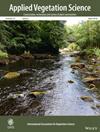Long-Term Deer Exclusion Releases Dwarf Bamboo, Reducing Vascular Plant Diversity
Abstract
Aims
Overgrazing by excessive deer populations harms native plant communities across most north temperate and boreal regions. In regions where deer impact is particularly severe, fencing is sometimes employed as a conservation measure to safeguard rare and threatened species and ecosystems. Here we examine how forest vascular plant communities have been affected by 21 years of sika deer exclusion by fencing of a 900 ha area.
Location
Nikko National Park, Tochigi prefecture, Japan.
Methods
We surveyed vascular plant cover in 240 plots and measured forest density on both sides of the fence in stands dominated by larch (Larix kaempferi) and oak (Quercus crispula).
Results
Vascular plant species richness was found to be lower in forest areas protected by the fence. At the same time, dwarf bamboo, often the most abundant understory component in Japanese open forests, was taller and denser inside the fence where deer had been excluded. In addition, the lack of natural tree regeneration inside the fence, likely due to strong dwarf bamboo competition, was also notable. This suggests that deer exclusion has benefitted dwarf bamboo while inhibiting the competition of other species, thereby lowering vascular plant richness. Vascular plant communities outside the fence instead seem to be strongly shaped by abundant sika deer; several species found there are known to be unpalatable or grazing tolerant, and there were few tree seedlings.
Conclusion
These results show that fencing to protect forest flora against overgrazing may have unintended consequences where there is a risk that competitive species can dominate understory plant communities. Instead of fencing, improved game management to maintain moderate deer populations may be a better strategy for large-scale conservation of forest flora and for promoting natural tree regeneration.


 求助内容:
求助内容: 应助结果提醒方式:
应助结果提醒方式:


